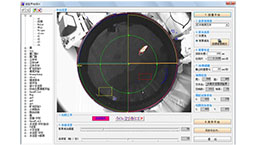Rat Model for Polycystic Ovarian Syndrome (PCOS)
Polycystic Ovary Syndrome
- Product No.DSI546Ra01
- Organism SpeciesRattus norvegicus (Rat) Same name, Different species.
- Prototype SpeciesHuman
- SourceTestosterone Propionate induced PCOS
- Model Animal StrainsSFF SD rats,healthy, female, ages: 6~8 weeks, about 200g.
- Modeling GroupingRandomly divided into three groups: model group (n = 30) , control group (n = 30) and the blank group (n = 30).
- Modeling Period6~8 weeks
- Modeling Method1 gram Testosterone Propionate powder(CAS:57-85-2) is dissolved in 100mL injection of sterile soybean oil, with 10mg/mL oil.
Model group rats with testosterone propionate, according to the body weight of 1mg/100g dose, continuous injection of 4-8 weeks; the control group received the same volume of sterile according to the weight of soybean oil, continuous injection of 4-8 weeks; blank group with no treatment. - ApplicationsDisease Model
- Downloadn/a
- UOM Each case
- FOB
US$ 240
For more details, please contact local distributors!
Model Evaluation
1. Vaginal smear test for estrous cycle
The smear of vaginal epithelial cell in control group rats showed a periodic change, cycle in 4-5 days, changes of estrous cycle; vaginal epithelial cells of rats in model group continued hyperkeratosis, it always in diestrus, estrous cycle of lost.
2. Determination of serum sex hormones
Biochemical tests showed that the level of testosterone(T) in model group increased significantly, follicle stimulating hormone(FSH), luteinizing hormone(LH), prolactin(RPL) level decreased.
Pathological Results
3. Changes in ovarian tissue
In model group, the pathological changes of the ovarian structure and ovarian follicles seen in cystic dilatation and showed cystic pathological changes, locking multiple follicular granulosa cells, retention cyst obviously reduced, theca cells increased
Cytokines Level
Statistical Analysis
SPSS software is used for statistical analysis, measurement data to mean ± standard deviation (x ±s), using t test and single factor analysis of variance for group comparison, P<0.05 indicates there was a significant difference, P<0.01 indicates there are very significant differences.
GIVEAWAYS
INCREMENT SERVICES
-
 Tissue/Sections Customized Service
Tissue/Sections Customized Service
-
 Serums Customized Service
Serums Customized Service
-
 Immunohistochemistry (IHC) Experiment Service
Immunohistochemistry (IHC) Experiment Service
-
 Small Animal In Vivo Imaging Experiment Service
Small Animal In Vivo Imaging Experiment Service
-
 Small Animal Micro CT Imaging Experiment Service
Small Animal Micro CT Imaging Experiment Service
-
 Small Animal MRI Imaging Experiment Service
Small Animal MRI Imaging Experiment Service
-
 Small Animal Ultrasound Imaging Experiment Service
Small Animal Ultrasound Imaging Experiment Service
-
 Transmission Electron Microscopy (TEM) Experiment Service
Transmission Electron Microscopy (TEM) Experiment Service
-
 Scanning Electron Microscope (SEM) Experiment Service
Scanning Electron Microscope (SEM) Experiment Service
-
 Learning and Memory Behavioral Experiment Service
Learning and Memory Behavioral Experiment Service
-
 Anxiety and Depression Behavioral Experiment Service
Anxiety and Depression Behavioral Experiment Service
-
 Drug Addiction Behavioral Experiment Service
Drug Addiction Behavioral Experiment Service
-
 Pain Behavioral Experiment Service
Pain Behavioral Experiment Service
-
 Neuropsychiatric Disorder Behavioral Experiment Service
Neuropsychiatric Disorder Behavioral Experiment Service
-
 Fatigue Behavioral Experiment Service
Fatigue Behavioral Experiment Service
-
 Nitric Oxide Assay Kit (A012)
Nitric Oxide Assay Kit (A012)
-
 Nitric Oxide Assay Kit (A013-2)
Nitric Oxide Assay Kit (A013-2)
-
 Total Anti-Oxidative Capability Assay Kit(A015-2)
Total Anti-Oxidative Capability Assay Kit(A015-2)
-
 Total Anti-Oxidative Capability Assay Kit (A015-1)
Total Anti-Oxidative Capability Assay Kit (A015-1)
-
 Superoxide Dismutase Assay Kit
Superoxide Dismutase Assay Kit
-
 Fructose Assay Kit (A085)
Fructose Assay Kit (A085)
-
 Citric Acid Assay Kit (A128 )
Citric Acid Assay Kit (A128 )
-
 Catalase Assay Kit
Catalase Assay Kit
-
 Malondialdehyde Assay Kit
Malondialdehyde Assay Kit
-
 Glutathione S-Transferase Assay Kit
Glutathione S-Transferase Assay Kit
-
 Microscale Reduced Glutathione assay kit
Microscale Reduced Glutathione assay kit
-
 Glutathione Reductase Activity Coefficient Assay Kit
Glutathione Reductase Activity Coefficient Assay Kit
-
 Angiotensin Converting Enzyme Kit
Angiotensin Converting Enzyme Kit
-
 Glutathione Peroxidase (GSH-PX) Assay Kit
Glutathione Peroxidase (GSH-PX) Assay Kit
-
 Cloud-Clone Multiplex assay kits
Cloud-Clone Multiplex assay kits
| Catalog No. | Related products for research use of Rattus norvegicus (Rat) Organism species | Applications (RESEARCH USE ONLY!) |
| DSI546Ra01 | Rat Model for Polycystic Ovarian Syndrome (PCOS) | Disease Model |
| TSI546Ra31 | Rat Ovary Tissue of Polycystic Ovarian Syndrome (PCOS) | Paraffin slides for pathologic research: IHC,IF and HE,Masson and other stainings |






